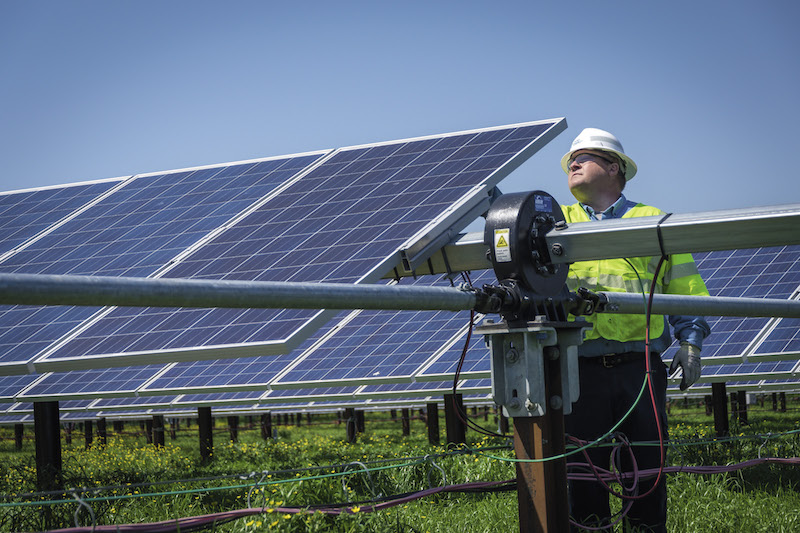Last week the independent administrator for Duke’s 680 MW solar solicitation revealed data about the projects which have bid in response to the offer, showing a massive amount of interest in the opportunity.
Overall, 18 individuals submitted bids for projects in Duke Energy Carolinas (DEC) territory and 10 in Duke Energy Progress (DEP), with a total of more than 3.9 GW of proposals – more nearly 6x the available volume. DEP was relatively more over-subscribed, with 1.2 GWac of projects vying for only 80 MW of available capacity.
This is despite a requirement that such projects come in below the estimate of Duke’s avoided cost for the next 20 years. Individual projects varied in capacity from 7-80 MWac, with most coming within the upper portion of that range.
These bids will be evaluated in the spring of 2019, and Duke Energy Communications Manager Randy Wheeless says he expects the plants to come online in a year or two.
Lack of storage
Despite recent trends, of the 78 bids that came in only four included integrated battery storage. Tyler Norris, Cypress Creek Renewables’ market lead for North Carolina, says that this reflects that the methodology used is not properly valuing storage.
“The lack of storage in these bids is a missed opportunity for the state, and it reflects a poorly designed avoided cost rate structure that improperly values storage resources, commercially unreasonable PPA provisions, and unfavorable interconnection treatment toward independent storage,” Norris told pv magazine.
“We’re hopeful that these issues will be addressed in the second RFP tranche and in the current regulatory proceedings on avoided cost and state interconnection standards.”
Limited volume for North Carolina?
Another curious feature of the bids is that nearly the same volume of solar has been proposed for South Carolina as North Carolina – despite this solicitation being in response to a North Carolina law.
Some online expressed disappointment in this outcome, including lobbyist and consultant Julie Robinson.
As 1 of the MANY ppl who worked on #HB589 last yr, I’m surprised & very disappointed by how much of Duke’s #solar RFP could be built in SC…NOT NC – nearly half🤯?!? The #NCGA intended for this new clean #energy, investments& jobs to benefit NC & our ppl. https://t.co/lxbngsDzMu https://t.co/i5LItaOkYc
— Julie Robinson (@JulieRobinsonNC) December 7, 2018
Tyler Norris has also argued that the overall volume is far less than what the industry can achieve.
Couldn’t agree more.
The basis for the renewables target (6,800MW) in NC’s landmark 2017 energy bill (589) was an outdated PNNL study – from 2014.
We can go way beyond it. Let’s get a separate, additional renewables RFP for SC and let each state reach its full potential. https://t.co/NFf19LOl85
— Tyler Norris (@tylerhnorris) December 8, 2018
It’s also far less than what may end up being built under other policies. Despite having the nation’s second-largest capacity of installed solar, over the course of 2017 PV provided only slightly more than 4% of North Carolina’s electricity.
This could change dramatically if the state acts on a recent executive order by Governor Roy Cooper (D), which calls for a 40% reduction in greenhouse gases by 2025. We at pv magazine USA think that solar could play a major role in achieving those reductions, and if the output of the state’s coal plants were replaced with solar it would mean another 18 GWac of solar over the next seven years, or around 2.5 GW each year.
This content is protected by copyright and may not be reused. If you want to cooperate with us and would like to reuse some of our content, please contact: editors@pv-magazine.com.









By submitting this form you agree to pv magazine using your data for the purposes of publishing your comment.
Your personal data will only be disclosed or otherwise transmitted to third parties for the purposes of spam filtering or if this is necessary for technical maintenance of the website. Any other transfer to third parties will not take place unless this is justified on the basis of applicable data protection regulations or if pv magazine is legally obliged to do so.
You may revoke this consent at any time with effect for the future, in which case your personal data will be deleted immediately. Otherwise, your data will be deleted if pv magazine has processed your request or the purpose of data storage is fulfilled.
Further information on data privacy can be found in our Data Protection Policy.